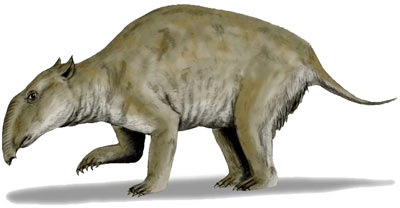
|
Search JoyZine with Google Site Search! |
Marsupial Tapir Palorchestes azeal
In 1988 the jawbone of a Palorchestes azeal, an animal the size of a bull, was found during trench excavations at Horseshoe Bend in Keilor. The animal's massive forelegs were equipped with 12cm-long, razor sharp claws whilst its strange head was equipped with a trunk. This large marsupial was initially described as a giant kangaroo due to the similarity of its cheek teeth to those of living kangaroos. Consequently, it was given the scientific name Palorchestes azeal, which is derived from Latin and means 'ancient leaper'. This creature has been called the 'marsupial tapir' because of its long nose. However, Palorchestes was not a tapir. As more fossil material of this animal has been discovered, scientists now know that Palorchestes was a marsupial species that appeared during the Miocene, and went extinct about 40,000 years ago. The genus Palorchestes first appears in the early late Miocene of Riversleigh in north-western Queensland (P. annulus, known from just a single, isolated M1/). The lineage persisted until the late Pleistocene, when the last known palorchestids, Palorchestes azeal (known only from the late Pleistocene) became extinct. Palorchestes azeal was an unusual marsupial herbivore with retracted nasal bones on the skull, suggesting that it may have had a small trunk like that of tapirs. There are extensive areas on the lower jaw for the attachment of powerful jaw musculature. Palorchestes also had huge, compressed claws and powerful front limbs. It was a ground dwelling marsupial that lived in a woodland habitat where, using its powerful forelimbs and razor sharp claws, it was capable of ripping through tough vegetation, such as bark on tree trunks, in order to obtain food. Its tongue was long and ribbon-like. As in all marsupials, Palorchestes would have borne tiny, poorly formed young that completed their development in the mother's pouch. Like their relatives the wombats, palorchestids probably had a backward-facing pouch (a legacy of their burrowing ancestry). Palorchestes azeal is the most widely distributed palorchestid, known from a variety of habitats. Fossils of P. azeal are known from Bluff Downs in south-eastern Queensland, from Naracoorte Caves in South Australia and Gippsland in Victoria (the type locality). Pleistocene Palorchestes species have been recovered from the Darling Downs, south-eastern Queensland. Palorchestids were diprotodontoids, differing sufficiently from Diprotodontidae (Diprotodontinae + Zygomaturinae) to warrant a separate family, Palorchestidae. Although the monophyly of this family has been questioned, a recent, large-scale phylogenetic analysis strongly supports the separation of palorchestids at the familial level. The six species of Palorchestes did not overlap in time. Over time, they became larger and their teeth became more high-crowned and complex. Palorchestes azeal differed from earlier species of Palorchestes (P. x, and P. anulus) in size (being the largest species in the genus) and in its dentition (it had well developed anterior and middle links on molars, and the upper third premolar, P3/ is simple, with three cusps). |
